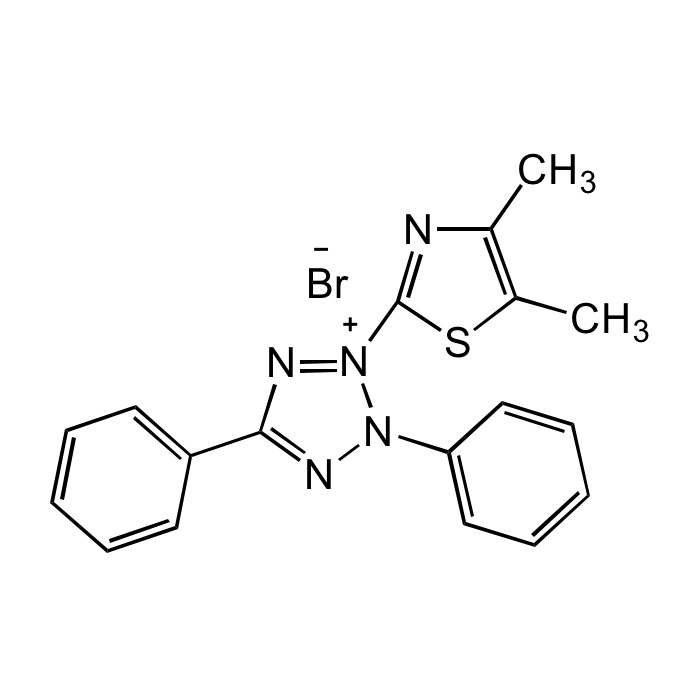Cookie Policy: This site uses cookies to improve your experience. You can find out more about our use of cookies in our Privacy Policy. By continuing to browse this site you agree to our use of cookies.
Chemodex
Thiazolyl blue tetrazolium bromide [MTT]

| Product Details | |
|---|---|
| Synonyms | 3-(4,5-Dimethyl-2-thiazolyl)-2,5-diphenyl-2H-tetrazolium bromide; MTT; Methylthiazolyldiphenyl-tetrazolium bromide; NSC 60102 |
| Product Type | Chemical |
| Properties | |
| Formula | C18H16BrN5S |
| MW | 414.32 |
| CAS | 298-93-1 |
| RTECS | XF8060000 |
| Source/Host Chemicals | Synthetic |
| Purity Chemicals | ≥98% (HPLC) |
| Appearance | Yellow powder. |
| Solubility | Soluble in water (5mg/ml). |
| Identity | Determined by 1H-NMR. |
| Declaration | Manufactured by Chemodex. |
| Other Product Data |
Click here for Original Manufacturer Product Datasheet |
| InChi Key | AZKSAVLVSZKNRD-UHFFFAOYSA-M |
| Smiles | CC1=C(C)SC([N+]2=NC(C3=CC=CC=C3)=NN2C4=CC=CC=C4)=N1.[Br-] |
| Shipping and Handling | |
| Shipping | AMBIENT |
| Short Term Storage | +4°C |
| Long Term Storage | +4°C |
| Handling Advice | Protect from light and moisture. |
| Use/Stability | Stable for at least 2 years after receipt when stored at +4°C. |
| Documents | |
| MSDS |
 Download PDF Download PDF |
| Product Specification Sheet | |
| Datasheet |
 Download PDF Download PDF |
MTT is a common histochemical/cytochemical reagent and for the detection of NAD. MTT is used to detect reductive metabolism in cells. It is a cell-permeable yellow dye that is reduced by intracellular NAD(P)H-oxidoreductases in mitochondria of living cells to form the dark blue water-insoluble MTT-formazan. The intensity of the color can then be measured spectrophotometrically at 540 or 570nm, which allows quantitation of cell viability and cell proliferation. It is frequently used in colorimetric assays to measure cell proliferation/cell growth, cytotoxicity (such as for screening cancer drugs), and apoptosis.
(1) M.A. Abdallah, & J.-F. Biellmann; Eur. J. Biochem. 112, 331 (1980) | (2) Y. Liu, et al.; J. Neurochem. 69, 581 (1997) | (3) M.V. Berridge, et al.; Biotechnol. Ann. Rev. 11, 127 (2005) | (4) T. Hayon, et al.; Leuk. Lymphoma 44, 1957 (2003) (Review) | (5) K. Praebst, et al.; Methods Mol. Biol. 1601, 1 (2017) | (6) P. Kumar, et al.; Cold Spring Harb. Protoc. 2018, pdb.prot095505 (2018) | (7) E. Grela, et al.; Acta Histochem. 120, 303 (2018) (Review)





